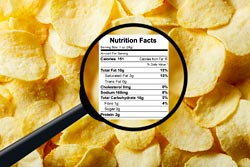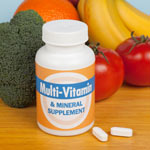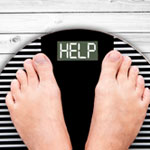Shocking Food Facts that May Change the Way You Eat

Has anyone ever asked, “Are you a hamburger with a large side of fries”? No? If you are what you eat, then perhaps the answer is yes. Feeling a bit guilty? Don’t feel bad, you’re not alone.
Even if you rarely eat fast food, if your diet is like the majority of Americans, it’s full of fattening, processed foods that aren’t the best for the heart or waistline. There is a great deal of conflicting information concerning diet and health, but there are also some shocking food facts that may change the way you eat forever.

Have you ever felt like you couldn’t eat just one? Perhaps you can eat just one serving of your favorite snack food, but most people don’t buy a small bag of potato chips with the intention of having it last for two or three snacks. Those tiny bags of chips rarely fill you up but they pack a caloric punch. The average serving size is about 11 chips. If you have 3-4 servings per bag and each serving is 200 calories, it adds up fast.
It’s not just chips. Serving sizes on many packages can be misleading. An item can look like it’s low calorie at a glance until you discover the actual serving size is small. For example, there are usually two servings in just one small can of soup. But how often do you make a can of soup and just eat half of it? The same often goes for serving sizes on everything from cereal, to cookies, to instant mashed potatoes. So next time you reach for your favorite snack food, carefully read the calories per serving and the serving size to calculate just how much you’re actually taking in.
Did you know the “5-second rule” is actually legit? Whether it involves a kindergartener dropping a cookie at recess or someone dropping the last hamburger at the barbeque, we’ve all heard someone bring up the 5-second rule. According to this 5-second rule it’s perfectly safe to consume food that has been dropped on the floor, so long as it’s picked up within 5 seconds. Whether or not it’s a fact that dropped food is really safe has always been debatable, but a new study sheds light on the subject.
According to a study done at Aston University, people that would rather risk it then waste food might have been right all along. Researchers tested a variety of different foods on surfaces from concrete, to tile, to carpet to see just how much harmful bacteria such as Staphylococcus and E. coli actually attach to food items within certain amounts of time. They discovered the amount of bacteria that attaches and how long it takes can depend on the type of food and the surface it’s dropped on. For example, wet food attracts more bacteria and carpet is a safer surface. However, what it all boils down to is that most food doesn’t become dangerous if it’s only touched the floor for a brief amount of time.
Another shocking food fact is that the meat might be full of fat, even chicken. A recent study conducted by the Institute of Brain Chemistry and Human Nutrition at London Metropolitan University found that chicken today has less protein and more fat than it did 40 years ago. According to the study, the average chicken has 33 percent less protein and more than 200 percent more fat than the average chicken did four decades ago. It isn’t just chickens that are becoming less healthy for humans to consume.
Factory farming often means animals are raised in cramped quarters and fed diets that aren’t natural. The result is that cows, pigs, chickens and other animals raised in factory farms have more fat and less protein than if they were raised in a more natural environment and given a natural diet. You may also miss out on healthy nutrients like vitamin E and omega-3 fatty acids if you only eat meat that has been factory farmed.
Have you ever wondered whether or not the dyes in your food were safe? Did you know that food manufacturers often add dyes to food to change the way it looks? Why do they do it? Because these artificial dyes are often more appealing to the eye than natural colorings. Artificial dyes may be doing more to your food than just making it a more appetizing color. Some of the chemicals found in dyes have been linked to hyperactivity in children.
Yellow No.5 and Yellow No.6, two dyes still found in food items today, have been connected to hyperactivity in children according to recent studies at Columbia and Harvard University. Researchers found that children who consumed food and drinks containing these dyes experienced significant increases in hyperactivity compared to children who did not consume foods with artificial dyes. The FDA has already banned several artificial food dyes connected with negative side effects in consumers.
Additionally, “no trans fat” labeled foods often contain trans fat. Trans fats or trans fatty acids are created when hydrogen is added to liquid vegetable oils to make them more solid. Trans fats raise your LDL (bad) cholesterol levels and may increase your risk of stroke and heart disease. Eating foods with trans fatty acids can also raise your risk of developing type 2 diabetes. According to the American Heart Association, it is wise to limit consumption of trans fatty acids to less than 1 percent of your total daily calories. Since trans fats naturally occur in meat and dairy foods, most people have no room left in their diets to take in additional trans fats.
Avoiding foods with trans fat is a healthy choice many consumers make, but no matter how much you might try to avoid it, you may still be consuming it inadvertently. That’s because the government allows food manufactures to round anything less than 0.5 to zero when it comes to counting trans fat. Although 0.5 doesn’t sound too high, once you start adding up the fat from several servings and several different types of “trans-fat-free” foods consumed in one day you may actually be taking in quite a bit more than you think.
You might also be interested in...
-
 6 Foods That Feed Your Brain
6 Foods That Feed Your Brain
-
 6 Things To Give Up This Year
6 Things To Give Up This Year
-
 7 Common Relationship Deal-Breakers
7 Common Relationship Deal-Breakers
-
 7 Facts Women Should Know About Heart Disease
7 Facts Women Should Know About Heart Disease
-
 When You Already Feel Like Giving Up On Your Resolutions
When You Already Feel Like Giving Up On Your Resolutions
-
 Amazing Tips To Help You Get Through Allergy Season
Amazing Tips To Help You Get Through Allergy Season
-
 Anti-Aging Tips And Tricks
Anti-Aging Tips And Tricks
-
 Are Protein Shakes A Healthy Choice?
Are Protein Shakes A Healthy Choice?
-
 Are We More Stressed Than the Rest of the World
Are We More Stressed Than the Rest of the World
-
 Are You Ruining Your Relationship
Are You Ruining Your Relationship
-
 Are You Socially Awkward?
Are You Socially Awkward?
-
 Attitude Of Gratitude
Attitude Of Gratitude
-
 Beating Work Burnout is Easier than You Think
Beating Work Burnout is Easier than You Think
-
 Benefits Of Yoga And Meditation
Benefits Of Yoga And Meditation
-
 Beware Of Relationship Killers
Beware Of Relationship Killers
-
 Big Cities Surprisingly Great for Outdoorsy People
Big Cities Surprisingly Great for Outdoorsy People
-
 How To Boost Your Self Confidence
How To Boost Your Self Confidence
-
 Can Saying You’re Sorry Save Your Life?
Can Saying You’re Sorry Save Your Life?
-
 Can White Wines Be Healthy Too
Can White Wines Be Healthy Too
-
 Changing Careers In Your 40s
Changing Careers In Your 40s
-
 Divorced, But Are You Ready To Start Dating Again?
Divorced, But Are You Ready To Start Dating Again?
-
 Do You Fight Like Other Couples?
Do You Fight Like Other Couples?
-
 When you don't have a green thumb
When you don't have a green thumb
-
 8 PreWorkout Meals To Maximize Results
8 PreWorkout Meals To Maximize Results
-
 Financial Benefits Of Co-Habitation vs Marriage
Financial Benefits Of Co-Habitation vs Marriage
-
 Financial Tips To Follow During And After Divorce
Financial Tips To Follow During And After Divorce
-
 Five Ways To Lead A Regret-Free Life
Five Ways To Lead A Regret-Free Life
-
 Why Your Friends Should Be Jealous If You’re 30-Something And Single
Why Your Friends Should Be Jealous If You’re 30-Something And Single
-
 Can A Full Moon Really Affect People?
Can A Full Moon Really Affect People?
-
 Getting a Life Insurance Quote Without Getting a Medical Exam
Getting a Life Insurance Quote Without Getting a Medical Exam
-
 Health Benefits Of Almond Milk
Health Benefits Of Almond Milk
-
 The Health Benefits Of Avocado
The Health Benefits Of Avocado
-
 Health Benefits Of Cinnamon
Health Benefits Of Cinnamon
-
 How To Choose A Multivitamin?
How To Choose A Multivitamin?
-
 How To Make The New Year The Best One Yet
How To Make The New Year The Best One Yet
-
 How To Prepare For Your Next Interview
How To Prepare For Your Next Interview
-
 Is a Co-worker Making You Hate Your Job?
Is a Co-worker Making You Hate Your Job?
-
 Is The Ketogenic Diet Safe?
Is The Ketogenic Diet Safe?
-
 Is Music The Antidote For Depression
Is Music The Antidote For Depression
-
 Is Your Diet Making You Feel More Stress?
Is Your Diet Making You Feel More Stress?
-
 How To Keep Your Facebook Safe From Scammers
How To Keep Your Facebook Safe From Scammers
-
 Life Insurance Companies Offer Protection
Life Insurance Companies Offer Protection
-
 Living With Fibromyalgia
Living With Fibromyalgia
-
 How To Look Better Than Ever At 40
How To Look Better Than Ever At 40
-
 More Big Cities Surprisingly Great for Outdoorsy People
More Big Cities Surprisingly Great for Outdoorsy People
-
 Natural Remedies For Acid Reflux
Natural Remedies For Acid Reflux
-
 No Medical Exam Life Insurance—Simple Application
No Medical Exam Life Insurance—Simple Application
-
 10 Olympic Sports That Didn’t Make the Cut
10 Olympic Sports That Didn’t Make the Cut
-
 Outrageous Facts about U.S. Presidents
Outrageous Facts about U.S. Presidents
-
 Ovarian Cancer--The Silent Killer
Ovarian Cancer--The Silent Killer
-
 Overcoming Frustration
Overcoming Frustration
-
 How To Get Relief From Credit Card Debt
How To Get Relief From Credit Card Debt
-
 Is There A Risk of Heart Disease Due To Drinking?
Is There A Risk of Heart Disease Due To Drinking?
-
 Shocking Food Facts that May Change the Way You Eat
Shocking Food Facts that May Change the Way You Eat
-
 Sick Of Running? 5 Cardio Routines You Should Try Instead
Sick Of Running? 5 Cardio Routines You Should Try Instead
-
 Smart Tips for Getting Paid What You Really Deserve
Smart Tips for Getting Paid What You Really Deserve
-
 Strange Laws You Don't Even Know You're Breaking
Strange Laws You Don't Even Know You're Breaking
-
 The Singles’ Guide To Life Insurance
The Singles’ Guide To Life Insurance
-
 Things To Remember When Buying Life Insurance
Things To Remember When Buying Life Insurance
-
 Top 5 Things You Need To Know About Life Insurance
Top 5 Things You Need To Know About Life Insurance
-
 Top 6 Factors That Destroy Your Credit Score
Top 6 Factors That Destroy Your Credit Score
-
 Top Ten Health Tips For Active Women Over 50
Top Ten Health Tips For Active Women Over 50
-
 Treating Menopause Symptoms With Alternative Medicine
Treating Menopause Symptoms With Alternative Medicine
-
 Want To Know How Your Interview Went? Think Of It Like A First Date…
Want To Know How Your Interview Went? Think Of It Like A First Date…
-
 What Every Woman Should Know About Breast Cancer
What Every Woman Should Know About Breast Cancer
-
 What Is Ruining Your Workout
What Is Ruining Your Workout
-
 What Most 30–Somethings Wish They’d Known in Their 20s
What Most 30–Somethings Wish They’d Known in Their 20s
-
 Whats Really To Blame For Your Bad Mood
Whats Really To Blame For Your Bad Mood
-
 Why You Keep Overeating and How to Stop
Why You Keep Overeating and How to Stop
-
 Why You Need To Talk About Life Insurance
Why You Need To Talk About Life Insurance
-
 You Can't Afford to Believe These Women's Health Myths
You Can't Afford to Believe These Women's Health Myths
-
 5 Plants To Keep In Your Bedroom
5 Plants To Keep In Your Bedroom
-
 Five Simple Ways To Protect Your Retirement
Five Simple Ways To Protect Your Retirement
-
 The Best Ways To Cover Gray Hair
The Best Ways To Cover Gray Hair
-
 5 Hidden Causes Of High Blood Pressure
5 Hidden Causes Of High Blood Pressure
-
 10 Steps To Get Through The Holidays Stress-Free
10 Steps To Get Through The Holidays Stress-Free
-
 5 Ways To Break A Bad Habit
5 Ways To Break A Bad Habit
-
 The 5 Benefits Of A Veterans Home Loan
The 5 Benefits Of A Veterans Home Loan
-
 Top 5 Prevention Tips For Heart Disease And Stroke
Top 5 Prevention Tips For Heart Disease And Stroke
-
 5 Surprising Facts About Low-Carb Diets
5 Surprising Facts About Low-Carb Diets
-
 7 Ways To Live A Happier Life
7 Ways To Live A Happier Life
-
 6 Tips To Be More Productive
6 Tips To Be More Productive
-
 7 Steps To Help Someone Who Is Grieving
7 Steps To Help Someone Who Is Grieving
-
 4 Reasons Why Your Diet Resolutions May Be Counterproductive
4 Reasons Why Your Diet Resolutions May Be Counterproductive
-
 Deciding On Braces After 40
Deciding On Braces After 40
-
 Why A Massage May Be Helpful For Back Pain
Why A Massage May Be Helpful For Back Pain
-
 How To Have Self-Compassion
How To Have Self-Compassion
-
 How To Stay Productive When You Don’t Feel Like it
How To Stay Productive When You Don’t Feel Like it
-
 Foods To Eat When You’re Feeling Stressed
Foods To Eat When You’re Feeling Stressed
-
 How Helping Others Can Make You Happier
How Helping Others Can Make You Happier
-
 Why You Don’t Have To Fear Fat When Dieting
Why You Don’t Have To Fear Fat When Dieting
-
 6 Things You Should Do To Live Without Regret
6 Things You Should Do To Live Without Regret
-
 How To Create Your Own Happiness
How To Create Your Own Happiness
-
 How To Get Immediate Stress Relief
How To Get Immediate Stress Relief
-
 Why It May Be Time To Make Some Changes
Why It May Be Time To Make Some Changes
-
 Why You May Want To Sleep On Your Left Side
Why You May Want To Sleep On Your Left Side
-
 4 Health Symptoms You Should Never Ignore
4 Health Symptoms You Should Never Ignore
-
 Dos And Don’ts Of Job Interviews
Dos And Don’ts Of Job Interviews
-
 How You Can Benefit From Showing A Little Love
How You Can Benefit From Showing A Little Love
-
 Can Debt Affect Your Health?
Can Debt Affect Your Health?
-
 What Women In Their 50s Know
What Women In Their 50s Know
-
 Hidden Reasons For Night Sweats
Hidden Reasons For Night Sweats
-
 5 Simple Lung Cancer Prevention Tips
5 Simple Lung Cancer Prevention Tips
-
 Why You Should Get Out Of Your Comfort Zone Now
Why You Should Get Out Of Your Comfort Zone Now
-
 7 Tips To Keep Runners Safe
7 Tips To Keep Runners Safe
-
 How To Stop Emotional Eating Now
How To Stop Emotional Eating Now
-
 Reach Your Potential In 4 Steps
Reach Your Potential In 4 Steps
-
 5 Ultimate Weight Loss Hacks
5 Ultimate Weight Loss Hacks
-
 Can Social Media Help With Weight Loss
Can Social Media Help With Weight Loss
-
 How A Good Impression Can Change Everything
How A Good Impression Can Change Everything
-
 Must-Know Travel Tips If You Want To Stay Safe
Must-Know Travel Tips If You Want To Stay Safe
-
 Three New Ways To Make Big Changes
Three New Ways To Make Big Changes
-
 The Hidden Benefits Of Ginger
The Hidden Benefits Of Ginger
-
 5 Tricks To Slim Down Fast
5 Tricks To Slim Down Fast
-
 How To Finally Wake Up Better
How To Finally Wake Up Better
-
 5 Chemical-Free Ways To Keep Skin Young
5 Chemical-Free Ways To Keep Skin Young
-
 The Secret Benefits Of Salt
The Secret Benefits Of Salt
-
 Why Be An Organ Donor?
Why Be An Organ Donor?
-
 How To Relieve Stomach Ulcers Fast
How To Relieve Stomach Ulcers Fast
-
 Disaster Relief Do’s And Don’ts
Disaster Relief Do’s And Don’ts
-
 How To Say Goodbye To A Loved One
How To Say Goodbye To A Loved One
-
 4 Tricks To Prevent A Cybercrime Attack
4 Tricks To Prevent A Cybercrime Attack
-
 The Dos And Don’ts Of Getting A Tattoo
The Dos And Don’ts Of Getting A Tattoo
-
 What To Do When Hearing Loss Strikes
What To Do When Hearing Loss Strikes
-
 How Auto Ship Programs Keep Scamming People
How Auto Ship Programs Keep Scamming People
-
 How To Decrease Stress And Increase Productivity
How To Decrease Stress And Increase Productivity
-
 Unique Relief For Chronic Neck Pain
Unique Relief For Chronic Neck Pain
-
 Ransomware–What It Is And How To Avoid Attack
Ransomware–What It Is And How To Avoid Attack
-
 Five Reasons To Drink More Tea
Five Reasons To Drink More Tea
-
 5 Major Life Events That May Require Life Insurance
5 Major Life Events That May Require Life Insurance
-
 6 Reasons Newlyweds Should Consider Life Insurance
6 Reasons Newlyweds Should Consider Life Insurance
-
 How Long Does It Take to Get a Life Insurance Policy?
How Long Does It Take to Get a Life Insurance Policy?
-
 How Long Does It Take to Get Life Insurance Money?
How Long Does It Take to Get Life Insurance Money?
-
 What You Need To Know About Mortgage Assistance Programs
What You Need To Know About Mortgage Assistance Programs
-
 How to Build a Better Resume: 7 Helpful Tips
How to Build a Better Resume: 7 Helpful Tips
-
 4 Things Women Should Do During Breast Cancer Awareness Month
4 Things Women Should Do During Breast Cancer Awareness Month
-
 10 Ways to Get More Out of Life
10 Ways to Get More Out of Life
-
 Who Owns Globe Life and Accident Insurance Company?
Who Owns Globe Life and Accident Insurance Company?
-
 Can I Buy Life Insurance Online?
Can I Buy Life Insurance Online?
-
 Cancelling My Life Insurance. What are My Options?
Cancelling My Life Insurance. What are My Options?
-
 Can Life Insurance be Purchased on Anyone by Anyone?
Can Life Insurance be Purchased on Anyone by Anyone?
-
 Understanding Insurance Claims: Complex Causes of Accidental Death
Understanding Insurance Claims: Complex Causes of Accidental Death
-
 How Can I Sell My Life Insurance Policy?
How Can I Sell My Life Insurance Policy?
-
 Checking Your Insurance Coverage Before Traveling Abroad: What to Know
Checking Your Insurance Coverage Before Traveling Abroad: What to Know
-
 Can I Convert My Term Life Insurance into a Whole Life Insurance Policy?
Can I Convert My Term Life Insurance into a Whole Life Insurance Policy?
-
 Should I Buy Enough Life Insurance to Pay Off My Mortgage?
Should I Buy Enough Life Insurance to Pay Off My Mortgage?
-
 What Is Whole Life Insurance?
What Is Whole Life Insurance?
-
 Beyond Active Duty: Life Insurance Options for US Veterans
Beyond Active Duty: Life Insurance Options for US Veterans
-
 The Risk of Having a Stroke for People Under 40
The Risk of Having a Stroke for People Under 40
-
 Is Drowning Considered an Accidental Death for Insurance Purposes?
Is Drowning Considered an Accidental Death for Insurance Purposes?
-
 How Long is a Term Life Insurance Policy?
How Long is a Term Life Insurance Policy?
-
 Tips for Choosing a Life Insurance Beneficiary
Tips for Choosing a Life Insurance Beneficiary

 Insurance products are available in New York from
Insurance products are available in New York from  Insurance products are available in your state from
Insurance products are available in your state from 





























































































































































